
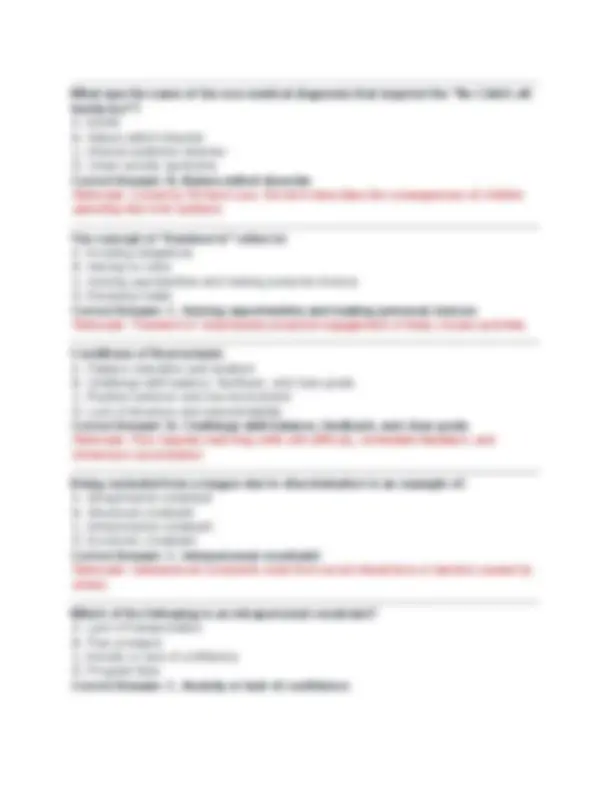
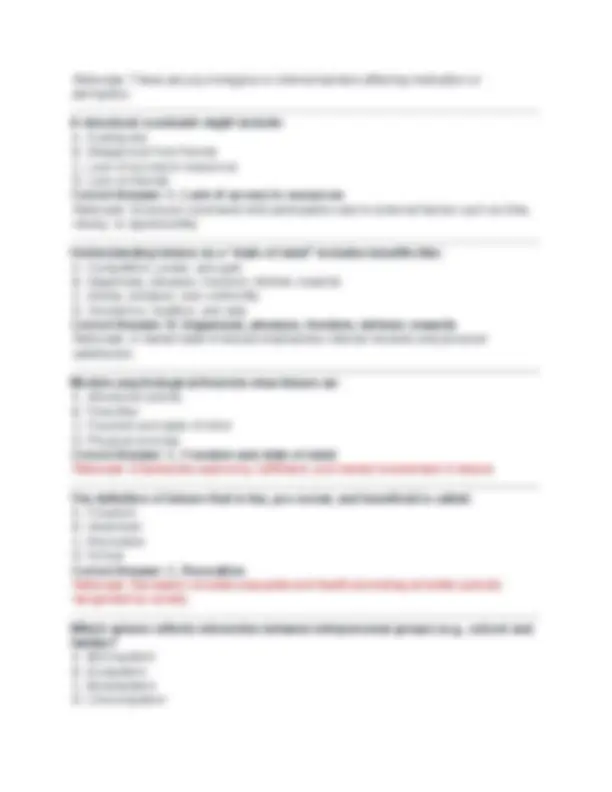
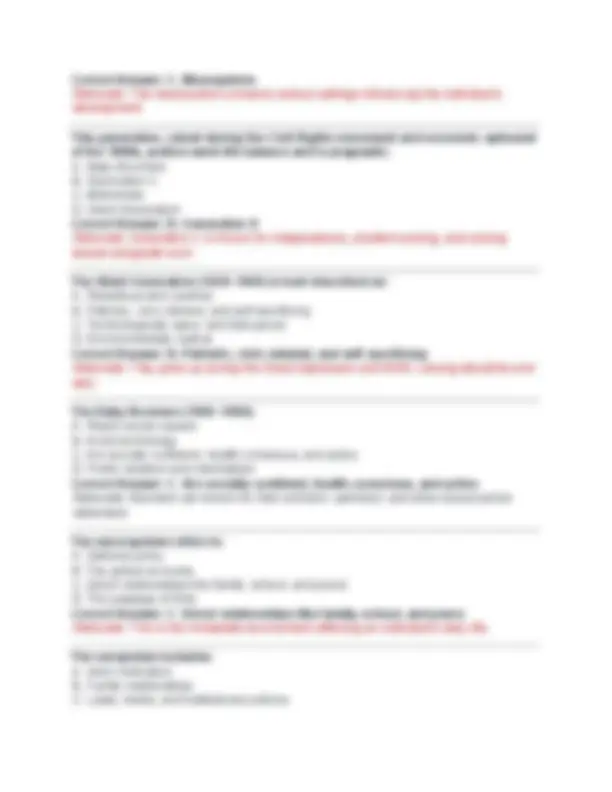
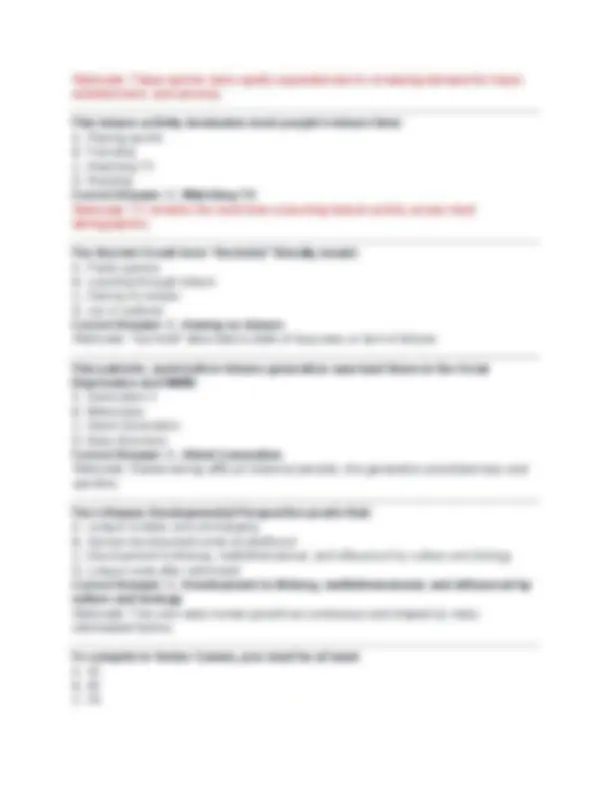

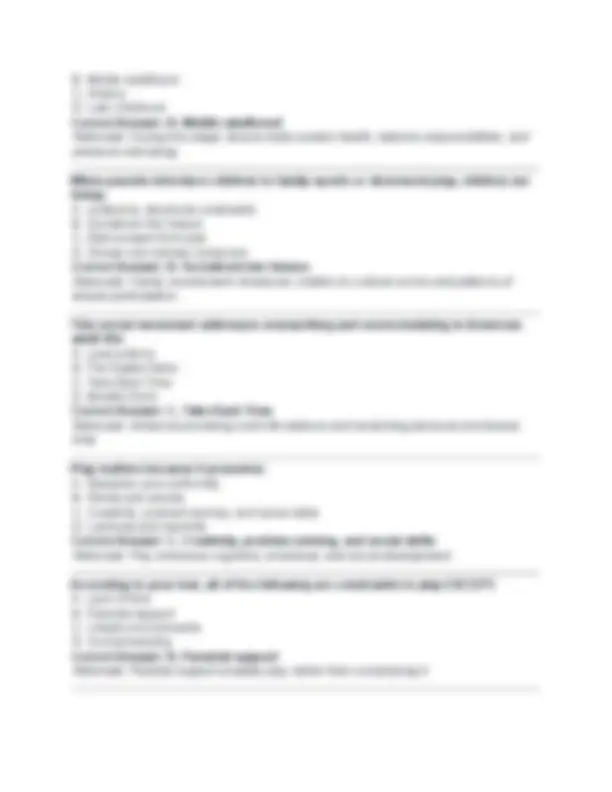





















Study with the several resources on Docsity

Earn points by helping other students or get them with a premium plan


Prepare for your exams
Study with the several resources on Docsity

Earn points to download
Earn points by helping other students or get them with a premium plan
Community
Ask the community for help and clear up your study doubts
Discover the best universities in your country according to Docsity users
Free resources
Download our free guides on studying techniques, anxiety management strategies, and thesis advice from Docsity tutors
Who was the first person to promote the idea that leisure was performed for its own sake? A. Plato B. Aristotle C. Socrates D. Cicero Correct Answer: B. Aristotle Rationale: Aristotle viewed leisure as essential to human flourishing and believed it was pursued for its own intrinsic value, not for utility. What are the three innate needs that promote a person's sense of intrinsic satisfaction? A. Wealth, power, fame B. Knowledge, security, tradition C. Competence, autonomy, relatedness D. Passion, energy, resilience Correct Answer: C. Competence, autonomy, relatedness Rationale: These three needs are central to Self-Determination Theory and are essential for intrinsic motivation and psychological growth.
Typology: Exams
1 / 33

This page cannot be seen from the preview
Don't miss anything!


























Who was the first person to promote the idea that leisure was performed for its own sake? A. Plato B. Aristotle C. Socrates D. Cicero Correct Answer: B. Aristotle Rationale: Aristotle viewed leisure as essential to human flourishing and believed it was pursued for its own intrinsic value, not for utility. What are the three innate needs that promote a person's sense of intrinsic satisfaction? A. Wealth, power, fame B. Knowledge, security, tradition C. Competence, autonomy, relatedness D. Passion, energy, resilience Correct Answer: C. Competence, autonomy, relatedness Rationale: These three needs are central to Self-Determination Theory and are essential for intrinsic motivation and psychological growth. In Neulinger's paradigm, the distinction between leisure and non-leisure is made by: A. Free time and energy level B. Money and availability C. Perceived freedom and intrinsic motivation D. Social expectations and status Correct Answer: C. Perceived freedom and intrinsic motivation Rationale: Neulinger's model focuses on perceived freedom and whether activities are done for intrinsic rewards to define leisure.
Unconditional leisure is: A. Structured and externally motivated B. Freely chosen for intrinsic satisfaction C. Required by social obligation D. Passive and unintentional Correct Answer: B. Freely chosen for intrinsic satisfaction Rationale: It is high in perceived freedom and done for its own sake, regardless of any external rewards. Recuperative leisure is: A. Mandatory for productivity B. Chosen freely with social intent C. Used to relax and restore well-being D. Motivated by competition Correct Answer: C. Used to relax and restore well-being Rationale: Though intrinsically meaningful, it often feels less free due to physical or emotional exhaustion. Relational leisure is: A. Done in solitude for reflection B. Mandated by an authority figure C. Chosen for the sake of spending time with others D. Performed as a duty Correct Answer: C. Chosen for the sake of spending time with others Rationale: It is a freely chosen activity that involves meaningful social interaction. Role-determined leisure is: A. Chosen freely for fun B. Done to fulfill expectations of others C. Completely spontaneous and personal D. Unstructured and unguided Correct Answer: B. Done to fulfill expectations of others Rationale: Though social in nature, it is low in perceived freedom and often driven by obligation. The idea that our lives are interdependent and shaped by close relationships is called: A. Flow theory B. Cognitive association C. Linked lives D. Self-determination Correct Answer: C. Linked lives Rationale: From life course theory, "linked lives" recognizes the influence of others on an individual's experiences.
Rationale: These are psychological or internal barriers affecting motivation or perception. A structural constraint might include: A. Feeling shy B. Disapproval from friends C. Lack of access to resources D. Lack of interest Correct Answer: C. Lack of access to resources Rationale: Structural constraints limit participation due to external factors such as time, money, or opportunities. Understanding leisure as a “state of mind” includes benefits like: A. Competition, power, and gain B. Happiness, pleasure, freedom, intrinsic rewards C. Stress, pressure, and conformity D. Obedience, tradition, and duty Correct Answer: B. Happiness, pleasure, freedom, intrinsic rewards Rationale: A mental state of leisure emphasizes internal rewards and personal satisfaction. Modern psychological theories view leisure as: A. Structured activity B. Time-filler C. Freedom and state of mind D. Physical exercise Correct Answer: C. Freedom and state of mind Rationale: Emphasizes autonomy, fulfillment, and mental involvement in leisure. The definition of leisure that is fun, pro-social, and beneficial is called: A. Freedom B. Hedonism C. Recreation D. Schole Correct Answer: C. Recreation Rationale: Recreation includes enjoyable and health-promoting activities typically recognized by society. Which sphere reflects interaction between interpersonal groups (e.g., school and family)? A. Microsystem B. Exosystem C. Mesosystem D. Chronosystem
Correct Answer: C. Mesosystem Rationale: The mesosystem connects various settings influencing the individual’s development. This generation, raised during the Civil Rights movement and economic upheaval of the 1980s, prefers work-life balance and is pragmatic: A. Baby Boomers B. Generation X C. Millennials D. Silent Generation Correct Answer: B. Generation X Rationale: Generation X is known for independence, problem-solving, and valuing leisure alongside work. The Silent Generation (1929–1945) is best described as: A. Rebellious and carefree B. Patriotic, civic-minded, and self-sacrificing C. Technologically savvy and fast-paced D. Environmentally radical Correct Answer: B. Patriotic, civic-minded, and self-sacrificing Rationale: They grew up during the Great Depression and WWII, valuing discipline and duty. The Baby Boomers (1946–1964): A. Reject social causes B. Avoid technology C. Are socially confident, health-conscious, and active D. Prefer isolation and minimalism Correct Answer: C. Are socially confident, health-conscious, and active Rationale: Boomers are known for their activism, optimism, and drive toward active retirement. The microsystem refers to: A. National policy B. The global economy C. Direct relationships like family, school, and peers D. The passage of time Correct Answer: C. Direct relationships like family, school, and peers Rationale: This is the immediate environment affecting an individual’s daily life. The exosystem includes: A. Inner motivation B. Family relationships C. Laws, media, and institutional policies
Rationale: Aristotle emphasized that leisure was not merely rest from labor but a noble pursuit for personal fulfillment. According to Goodale, which of the following is NOT linked to the decline of leisure? A. Time scarcity B. “I want it now” mentality C. Everything on credit D. Civic engagement Correct Answer: D. Civic engagement Rationale: Civic engagement is often associated with meaningful leisure, not its decline. This civilization popularized leisure as spectacle through “bread and circuses”: A. Greeks B. Egyptians C. Romans D. Persians Correct Answer: C. Romans Rationale: The Roman Empire entertained the masses with grand spectacles like gladiator games and free food. The ancient Greek term "schole" means public games. A. True B. False Correct Answer: B. False Rationale: "Schole" refers to leisure, not public games, which were more Roman in character. Concerns for urban sprawl and lack of open space led to growth in which leisure sub-industry? A. Commercial Recreation B. Cultural Arts C. Outdoor and Research-based Recreation D. Theme Parks Correct Answer: C. Outdoor and Research-based Recreation Rationale: The need for accessible nature and green spaces has fueled outdoor recreation programs and studies. The fastest-growing segment of the leisure service industry is: A. Sports B. Tourism and commercial recreation C. Fine arts D. Education Correct Answer: B. Tourism and commercial recreation
Rationale: These sectors have rapidly expanded due to increasing demand for travel, entertainment, and services. This leisure activity dominates most people's leisure time: A. Playing sports B. Traveling C. Watching TV D. Reading Correct Answer: C. Watching TV Rationale: TV remains the most time-consuming leisure activity across most demographics. The Ancient Greek term “Ascholia” literally meant: A. Public games B. Learning through leisure C. Having no leisure D. Joy in solitude Correct Answer: C. Having no leisure Rationale: “Ascholia” described a state of busyness or lack of leisure. This patriotic, work-before-leisure generation saw hard times in the Great Depression and WWII: A. Generation X B. Millennials C. Silent Generation D. Baby Boomers Correct Answer: C. Silent Generation Rationale: Raised during difficult historical periods, this generation prioritized duty and sacrifice. The Lifespan Developmental Perspective posits that: A. Leisure is static and unchanging B. Human development ends at adulthood C. Development is lifelong, multidimensional, and influenced by culture and biology D. Leisure ends after retirement Correct Answer: C. Development is lifelong, multidimensional, and influenced by culture and biology Rationale: This view sees human growth as continuous and shaped by many interrelated factors. To compete in Senior Games, you must be at least: A. 55 B. 60 C. 50
B. Middle adulthood C. Infancy D. Late childhood Correct Answer: B. Middle adulthood Rationale: During this stage, leisure helps sustain health, balance responsibilities, and preserve well-being. When parents introduce children to family sports or structured play, children are being: A. Limited by structural constraints B. Socialized into leisure C. Discouraged from play D. Shown non-intrinsic behaviors Correct Answer: B. Socialized into leisure Rationale: Family involvement introduces children to cultural norms and patterns of leisure participation. This social movement addresses overworking and overscheduling in American adult life: A. Less is More B. The Digital Detox C. Take Back Time D. Mindful Work Correct Answer: C. Take Back Time Rationale: Aimed at promoting work-life balance and reclaiming personal and leisure time. Play matters because it promotes: A. Discipline and conformity B. Stress and anxiety C. Creativity, problem-solving, and social skills D. Laziness and inactivity Correct Answer: C. Creativity, problem-solving, and social skills Rationale: Play enhances cognitive, emotional, and social development. According to your text, all of the following are constraints to play EXCEPT: A. Lack of time B. Parental support C. Unsafe environments D. Overscheduling Correct Answer: B. Parental support Rationale: Parental support enables play rather than constraining it.
According to Stuart Brown, Collective Play is: A. Solitary and rule-free B. Ritualized play in large groups (e.g., parades or religious ceremonies) C. Passive entertainment D. Individual meditation Correct Answer: B. Ritualized play in large groups (e.g., parades or religious ceremonies) Rationale: Collective play builds shared identity and community bonding. According to Stuart Brown, Social Play is: A. Group games that promote bonding and social interaction B. Solo sports C. Isolated digital gaming D. Structured academic activities Correct Answer: A. Group games that promote bonding and social interaction Rationale: Social play involves interacting with others and developing social skills. Solitary play is when: A. Children mimic adults B. Children observe others C. A child plays alone D. Children play in competitive teams Correct Answer: C. A child plays alone Rationale: Solitary play is crucial for self-discovery and independent thinking. Play is guided by mental rules: A. True B. False Correct Answer: A. True Rationale: Even in unstructured play, children often develop and follow imaginary or internal rules. Onlooker play is when: A. A child watches others play but does not participate B. A child plays alone C. A child competes in a game D. A child creates their own game Correct Answer: A. A child watches others play but does not participate Rationale: Onlooker play is an early stage of social development and observation learning. Parallel play is when: A. Two children share toys directly B. Children play next to each other but do not interact
Correct Answer: B. False Rationale: Unstructured play better supports creativity and flexible thinking, while structured play can limit spontaneity. Children do not get as much free play today because: A. They dislike outdoor activities B. They have access to better toys C. They are overscheduled and environments may be unsafe D. They prefer reading Correct Answer: C. They are overscheduled and environments may be unsafe Rationale: Increased structured activities and concerns about safety limit opportunities for spontaneous play. Organized sports can support child development when: A. Winning is the main goal B. There is pressure to specialize early C. Adults provide positive support and avoid pressure D. Coaches focus on championships Correct Answer: C. Adults provide positive support and avoid pressure Rationale: Supportive, fun environments foster personal growth, skill-building, and enjoyment. Time, money, and access to space are all examples of: A. Personal motivators B. Leisure constraints C. Play outcomes D. Social reinforcers Correct Answer: B. Leisure constraints Rationale: These structural factors can limit a person’s ability to participate in leisure or recreation. Serious leisure involves: A. Activities that are done only for fun B. Casual, spontaneous experiences C. Systematic pursuit requiring skill and commitment D. Mandatory school activities Correct Answer: C. Systematic pursuit requiring skill and commitment Rationale: Serious leisure is purposeful and fulfilling, like amateur hobbies or volunteering. According to self-determination theory, leisure is most satisfying when: A. It's competitive and structured B. It involves external rewards C. It meets the needs of autonomy, competence, and relatedness
D. It avoids all responsibility Correct Answer: C. It meets the needs of autonomy, competence, and relatedness Rationale: These three psychological needs are essential for intrinsic motivation and satisfaction. Which is an example of place attachment? A. Preferring expensive vacations B. Feeling connected to a neighborhood park C. Avoiding new environments D. Traveling constantly for leisure Correct Answer: B. Feeling connected to a neighborhood park Rationale: Place attachment is the emotional bond people form with meaningful places. Arousal theory suggests that people seek leisure activities: A. That require little energy B. That are always predictable C. To regulate their optimal level of excitement D. Only for relaxation Correct Answer: C. To regulate their optimal level of excitement Rationale: Arousal theory proposes that people engage in activities to maintain an optimal arousal level. Evidence-based benefits of leisure include: A. Increased consumerism B. Decreased physical activity C. Improved mental health and stress reduction D. Less time with family Correct Answer: C. Improved mental health and stress reduction Rationale: Research shows leisure contributes to well-being, resilience, and emotional health. Constraints to leisure can include all of the following EXCEPT: A. Lack of time B. Financial limitations C. Interest and motivation D. Physical disability Correct Answer: C. Interest and motivation Rationale: Interest and motivation are facilitators, not constraints. The others can prevent participation. Which is a form of active leisure? A. Watching television B. Reading a novel C. Hiking in a national park
D. Recreationally taxed Correct Answer: C. Leisure socialized Rationale: Leisure socialization refers to the process of learning and adopting leisure behaviors from others, particularly family. Play matters because it promotes: A. Laziness B. Economic success C. Physical, cognitive, and social development D. Constant excitement Correct Answer: C. Physical, cognitive, and social development Rationale: Play supports overall development, helping children grow in body, mind, and social understanding. According to your text, all of the following except which is a constraint to play? A. Safety concerns B. Lack of time C. Parental support D. Overscheduling Correct Answer: C. Parental support Rationale: Parental support enables play, whereas the others are constraints that limit a child’s ability to play freely. According to Stuart Brown’s TED Talk, Collective Play is: A. Play done alone B. Play involving group rituals and cooperation C. Watching sports as a group D. Working on a solo art project Correct Answer: B. Play involving group rituals and cooperation Rationale: Collective play involves shared group experiences, often involving community, tradition, or team dynamics. According to Stuart Brown’s TED Talk, Social Play is: A. Playing video games alone B. Competitive sports C. Interacting with others for enjoyment and connection D. Memorizing trivia facts Correct Answer: C. Interacting with others for enjoyment and connection Rationale: Social play includes activities like joking, storytelling, and group games that build relationships. Solitary play is when: A. A child watches others play but doesn’t join B. A child plays alone independently
C. A child only plays with adults D. A child mimics adult roles Correct Answer: B. A child plays alone independently Rationale: Solitary play refers to independent play without interaction with others. Play is guided by mental rules: A. Only during video games B. In all forms of play C. In imaginative and organized play D. Never, it’s always chaotic Correct Answer: C. In imaginative and organized play Rationale: Structured or imaginative play is often governed by internal rules, like role expectations or turn-taking. Onlooker play is when: A. Children play side by side but don’t interact B. A child watches others play but doesn’t participate C. A child pretends to be someone else D. A group follows the same play structure Correct Answer: B. A child watches others play but doesn’t participate Rationale: Onlooker play involves observing others’ play, often as a stage before active participation. Parallel play is when: A. Children mimic adult behavior B. Children interact and cooperate directly C. Children play near each other but not together D. Children take turns in a structured game Correct Answer: C. Children play near each other but not together Rationale: Parallel play is typical in early childhood, where children play beside but not with each other. According to Stuart Brown’s TED Talk, Spectator/Ritual Play is: A. Watching Netflix alone B. Participating in competitive games C. Observing or participating in group events with traditional or ceremonial elements D. Playing board games as a family Correct Answer: C. Observing or participating in group events with traditional or ceremonial elements Rationale: Spectator/Ritual Play involves communal experiences like sports, festivals, or rituals which period of life is leisure used to master our bodies and learn to socialize - ANSWER Infancy and childhood
Which of the following philosophers suggested "we live not for the past or the future, but for the present moment. We will always be measured by our conduct in the present."? - Ans - Augustine Someone who is biased towards viewing the present in light of a generally unhappy/negative view of the past is considered to hold which perspective? - Ans - past-negative Protracted duration refers to when: - Ans - Time seems to pass slowly The concept of time famine suggests that we have insufficient time to get work done. - Ans - False In terms of time-deepening, going to a drive thru restaurant is an example of: - Ans - Speed up Someone who is biased to think about the present in light of a helpless attitude towards life related to an external locus of control is considered to hold which perspective? - Ans
The pastimes or leisure activities of lower social or economic classes of people is referred to as: - Ans - In biocultural evolution, selection refers to: - Ans - Typical pastimes of the elite, usually refers to "high brow" uses of leisure are referred to:
Technological advances brought music from performance halls to individual listening and therefore have lessened their impact as resistance - Ans -